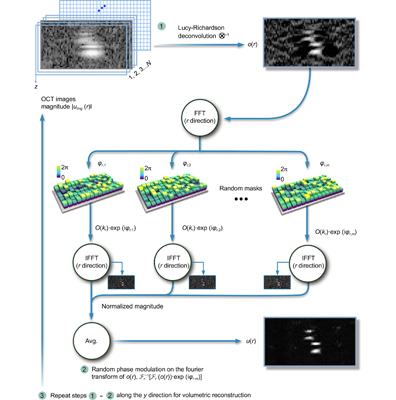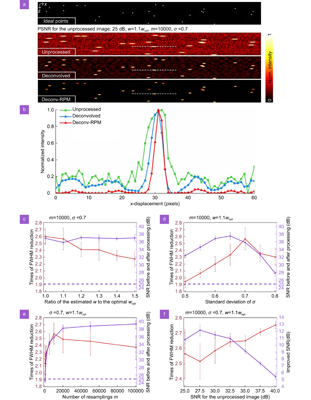Xin Ge, Si Chen, Kan Lin, Guangming Ni, En Bo, Lulu Wang, Linbo Liu. Deblurring, artifact-free optical coherence tomography with deconvolution-random phase modulation[J]. Opto-Electronic Science, 2024, 3(1): 230020
Search by keywords or author
- Opto-Electronic Science
- Vol. 3, Issue 1, 230020 (2024)

Fig. 1. Flow chart showing the processing steps of the Deconv-RPM method. uimg(r) is the acquired OCT frame (B-scan), where x is the B-scan direction, z is the depth direction. For simplicity, r represents any of the coordinates x or z in the case of B-scan and x, y or z for C-scan. N is the number of B-scans. In step 1, an iterative Richardson-Lucy deconvolution is performed to produce a deconvolved image o(r). In step 2, numerical random phase masks exp(iφm) are modulated on the O(kr), which is the Fourier space representations of o(r). For B-scan, 1-D FFT

Fig. 2. Effectiveness and resilience of the Deconv-RPM method through 1D simulation and analysis. (a ) Illustrative simulation results displayed on a logarithmic scale. The top row shows the ground truth of the spatial distribution of ideal points. The second row shows the unprocessed image of points blurred by a complex Gaussian function with additive Gaussian white noise, having a SNR of 25 dB. The third row is the deconvolved image processed by the Richardson-Lucy algorithm. The bottom row presents the image reconstructed by the two-step Deconv-RPM. (b ) Transverse intensity profiles of the selected point, as indicated by the white dashes, provide a comparative view. (c ) Effects of real-valued w estimation on FWHM reduction and SNR enhancement. (d ) The FWHM reduction and the SNR enhancement as functions of the standard deviation of normal random numbers σ. The choice of σ value depends on balancing FWHM reduction and SNR enhancement. (e ) The FWHM reduction and the SNR enhancement as functions of the number of resamplings m. At m equals 10000, the algorithm performance reaches a limit. The SNR for the unprocessed image in (a−e) is 25 dB. (f ) Restoration performance from a low SNR (25 dB) image to a high SNR (40 dB) image. Means and standard deviations in (c−f) are calculated based on 10 repeated simulations. Relative parameters are specified in the text. The number of iterations t for the deconvolution is fixed at 10. Data analysis in (c−f) is conducted on a linear scale.
Fig. 3. Imaging of particles suspension phantom acquired with micro-OCT (a ), processed with deconvolution only (b ) and Deconv-RPM (c ) on logarithmic scale . Scale bars: 10 μm. Inset: the green line represents the incident light which is reflected at the top and bottom surfaces of the microsphere (shown as a light dark circle). The red line illustrates the path of the illuminated and reflected light. These reflections create the paired signals in the OCT image, corresponding to the two surfaces of the microsphere. (d −e ) Close-up view (6×) of selected particles near (green dashed-line box) and outside (orange dashed-line box) the confocal region, respective 3-D intensity-surface plots of close-up view on the same display scale are shown on the right side. Scale bars: 1 μm. (f −g ) Corresponding profiles (yellow lines in (d) and (e)) across the hyper-reflective signals are shown to compare the resolved capability before and after processing, with a μm-per-pixel ratio of 0.525 in the transverse direction (f) and a μm-per-pixel ratio of 0.173 in the axial direction (g).
Fig. 4. Cross-sectional imaging of swine floor of mouth. (a –c ) Conventional image, Deconv-RPM image and Deconvolution image with 20 B-scan averages showing epithelium (EP) and lamina propria (LP). Scale bar: 50 μm. (d , e ) Enlarged 4× views of the selected sections from the conventional and Deconv-RPM images, demonstrating clearly identifiable nucleocytoplasmic boundaries, as indicated by pink arrowheads. Scale bar: 10 μm. (f ) Corresponding histology image from the swine floor of mouth, serving as an anatomical reference. Scale bar: 20 μm. (g –h ) Corresponding profiles (yellow dashed lines in (g) and (h)) across the hyper-reflective signals before and after processing, with a μm-per-pixel ratio of 0.218 in the transverse direction (g) and a μm-per-pixel ratio of 0.22 in the axial direction (h).
Fig. 5. Invivo imaging of human capillary. (a , b ) Representative μ-OCT image and segmented capillary region of human labial mucosa. Scale bars: 50 μm. (c ) The corresponding Deconv-RPM image. (b' , c' ) 3× zoomed view on blood cells in the capillary.
Fig. 6. Analysis of the impact of varying mean values of the normal distribution in random phase masks on image quality metrics. (a ) Variation of FWHM with different phase mask configurations, comparing original unprocessed data to Deconv-RPM data. (b ) Corresponding variation of SNR under the same conditions.
Fig. 7. Analysis of different phase mask distributions on Deconv-RPM images. (a ) Uniform distribution, (b ) Exponential distribution, and (c ) Poisson distribution. Solid lines represent the SNR and FWHM values for the original data and dashed lines represent Deconv-RPM results. Regions without data points in dashed lines signify NAN values. The blue curves denote SNR changes, while the red curves highlight FWHM changes.

Set citation alerts for the article
Please enter your email address



